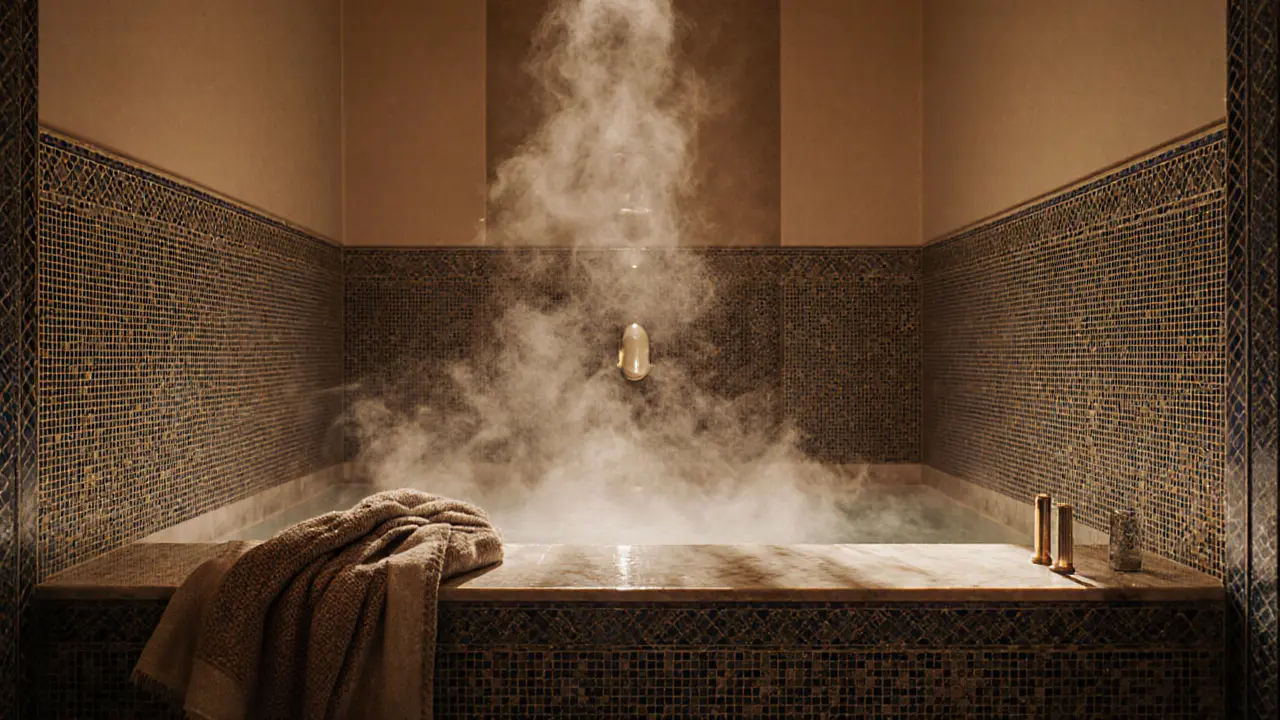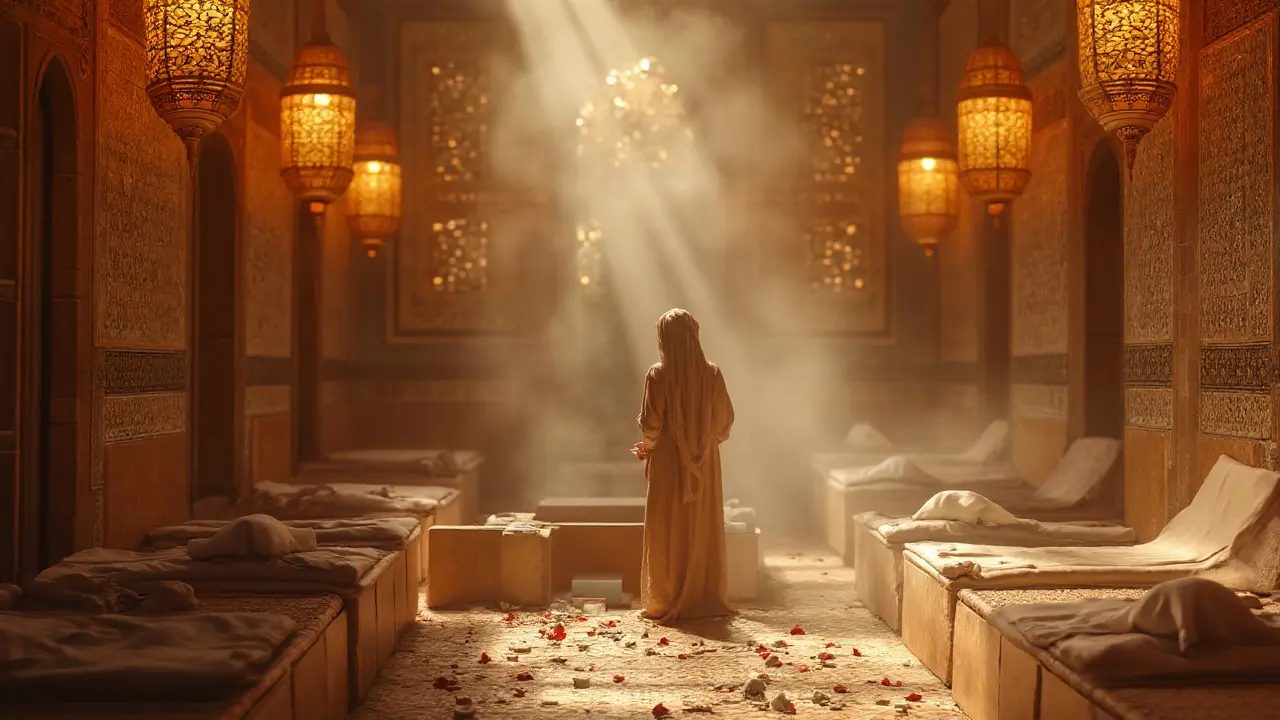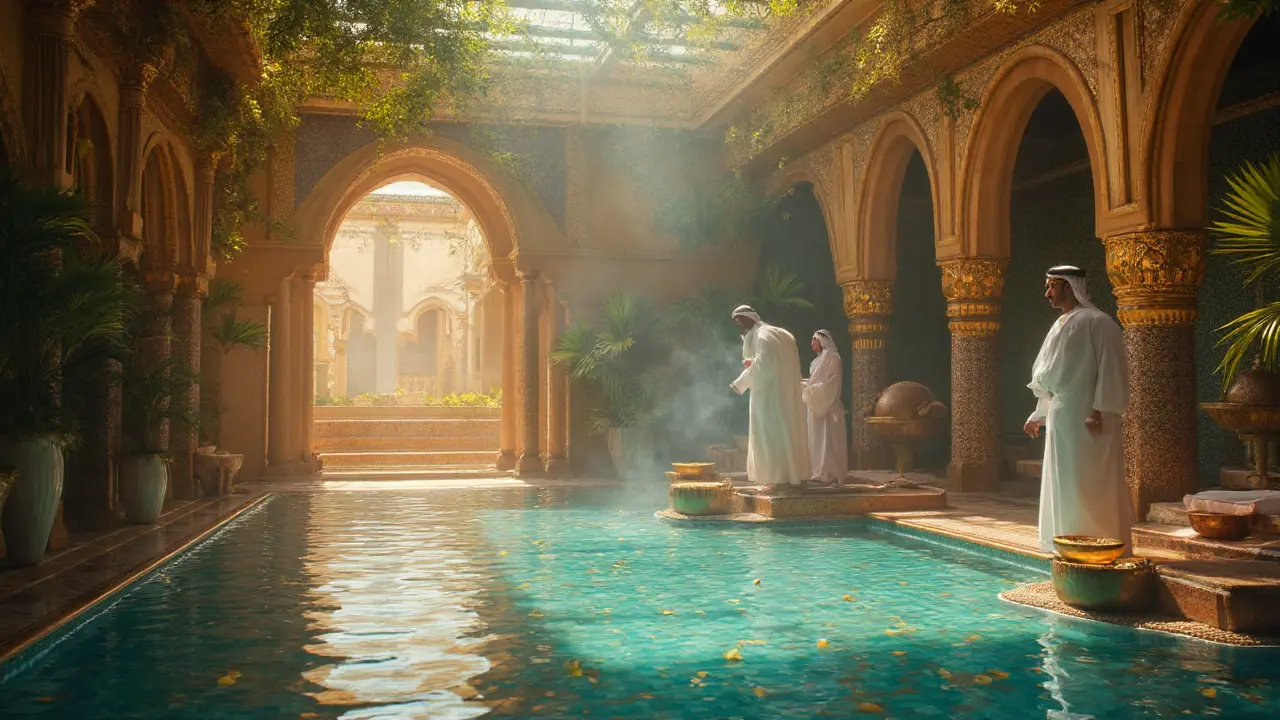What is the difference between a sauna and a Moroccan bath? If you’ve ever walked past a luxury spa in Dubai and wondered whether to pick the steamy, cedar-lined sauna room or the tiled, aromatic Moroccan bath, you’re not alone. Both promise deep relaxation, but they’re as different as a desert wind and a mountain spring. One is dry heat that makes you sweat like you’ve run a marathon. The other is humid, fragrant steam that feels like being wrapped in a warm, herbal hug. Let’s break down what each really is, how they feel, and which one might be your perfect reset button-especially here in Dubai, where wellness isn’t just a trend, it’s a lifestyle.
Understanding the Basics of Sauna and Moroccan Bath
Origins and History
The sauna comes from Finland, where it’s been a cultural cornerstone for over 2,000 years. Ancient Finns used stone-heated rooms to cleanse, heal, and even give birth. It wasn’t luxury-it was survival. The heat was dry, often hitting 80-100°C, and water was thrown on hot stones only occasionally to create a burst of steam-called löyly. Today, saunas are everywhere, from Finnish homes to high-end hotels in Dubai, but the core idea stays the same: intense dry heat to open pores and release tension.
The Moroccan bath, or hammam, has roots stretching back to Roman and Islamic traditions, blending ancient bathing rituals with North African spice culture. In Morocco, the hammam was-and still is-a weekly social ritual. Families gathered in tiled rooms, scrubbed with black soap, and rinsed with rosewater. The heat here is low and moist, usually 40-50°C, with humidity levels up to 100%. It’s not just about sweating; it’s about slow, ritualistic cleansing. In Dubai, you’ll find modern hammams with marble floors and lavender oil, but the soul of the tradition remains.
Core Principles or Components
A sauna is built for heat. Wood walls, stone heaters, and minimal moisture create an environment where your body sweats profusely to cool itself. The goal? To stimulate circulation, loosen tight muscles, and trigger a deep sense of calm through thermal stress. You sit or lie still. You don’t scrub. You just breathe and let the heat work.
A Moroccan bath, by contrast, is built for cleansing. The room is fully tiled, often with intricate zellige patterns, and features a central heated marble slab called a birka. Steam rises from a central boiler, carrying the scent of eucalyptus, argan oil, or black soap. The process involves exfoliation with a kessa glove, rinsing with warm water, and sometimes a massage. It’s not passive-it’s active. You’re part of the ritual.
How It Differs from Related Practices
Here’s a simple comparison:
| Feature | Sauna | Moroccan Bath |
|---|---|---|
| Heat Type | Dry heat (80-100°C) | Humid steam (40-50°C) |
| Moisture Level | Low (10-20%) | High (up to 100%) |
| Primary Focus | Detoxification, muscle relaxation | Cleansing, exfoliation, skin renewal |
| Duration | 10-20 minutes per session | 45-90 minutes total |
| Post-Session Feeling | Light, refreshed, slightly dehydrated | Soft, smooth, deeply cleansed |
Who Can Benefit from Sauna or Moroccan Bath?
If you’re an athlete recovering from a tough workout, a sauna might be your best friend. The dry heat helps reduce muscle soreness and speeds up recovery. Studies show that regular sauna use can lower cortisol levels and improve heart health-similar to light cardio. The National Institutes of Health notes that heat therapy supports cardiovascular function, making it a smart choice for those managing stress or blood pressure.
If your skin feels dull, your pores are clogged, or you’re tired of harsh scrubs, the Moroccan bath is a game-changer. The steam opens your pores deeply, and the physical exfoliation removes dead skin without chemicals. Many Dubai residents who work in air-conditioned offices all day find their skin improves dramatically after just one hammam session. It’s also ideal for people with eczema or psoriasis-gentle, natural, and non-irritating.
Benefits of Sauna and Moroccan Bath for Body and Mind
Stress Reduction
Both reduce stress-but in different ways. The sauna’s dry heat triggers a deep parasympathetic response. Your heart rate slows, your breathing deepens, and your mind quiets. It’s like hitting a reset button on your nervous system. People in Dubai who work long hours in finance or tech often say their sauna sessions are their only true ‘me time’.
The Moroccan bath works differently. The slow, rhythmic process-scrubbing, rinsing, resting-feels like a moving meditation. The scent of mint and eucalyptus, the warmth of the steam, the gentle touch of the attendant-it all slows your brain down. One regular at a Hammam Spa in Jumeirah told me, “It’s the only time I forget my phone exists.”
Enhanced Skin Health
Here’s where the Moroccan bath wins hands down. The combination of steam and physical exfoliation removes layers of dead skin, revealing a glow you can’t get from a store-bought scrub. The black soap used is made from olive oil and potassium hydroxide-natural, gentle, and deeply moisturizing. After a session, your skin feels like silk. Saunas can help too-by increasing blood flow to the skin-but they don’t physically remove buildup. That’s why many Dubai residents alternate: sauna for recovery, hammam for skin renewal.
Emotional Well-Being
There’s a cultural dimension here. In Morocco, the hammam is a social event. Families go together. Friends chat. Children are introduced to the ritual early. In Dubai, many hammams now offer private rooms, but the sense of calm and ritual still lingers. It’s not just a treatment-it’s a moment of stillness in a fast-paced city.
The sauna, on the other hand, is often solitary. You sit quietly, alone with your thoughts. For introverts or those who need mental space, that silence is healing. One woman I spoke to said, “After my divorce, the sauna became my therapist. No words needed.”
Practical Applications
Think of this: You’ve got a big presentation tomorrow. You’re tense. Should you go to the sauna or the hammam? If you need to release physical tension fast, the sauna. If you need to reset your whole system-mind, skin, spirit-the hammam. Many Dubai hotels now offer combo packages: 20 minutes in the sauna, then a full hammam treatment. It’s the ultimate recovery ritual.
| Benefit | Description | Impact |
|---|---|---|
| Detoxification | Sweating removes toxins through the skin | Improved immune function |
| Skin Renewal | Exfoliation removes dead cells | Glows, fewer breakouts |
| Stress Relief | Heat lowers cortisol | Better sleep, lower anxiety |
| Circulation Boost | Heat expands blood vessels | Faster muscle recovery |
What to Expect When Engaging with Sauna or Moroccan Bath
Setting or Context
Step into a sauna, and you’ll feel the dry, warm air hit your skin. The room is quiet, often dimly lit. You’ll find wooden benches, towels, and maybe a bucket of water and ladle for pouring over stones. It’s simple. Functional. No frills.
Step into a Moroccan bath, and it’s a sensory experience. The air is thick with steam. The walls gleam with hand-painted tiles. You’ll hear water dripping, soft music, and maybe the murmur of other guests. The floor is warm underfoot. There’s a central marble slab where you lie down. Everything is designed to slow you down.
Key Processes or Steps
For a sauna: Enter, sit or lie down, stay 10-20 minutes, cool off with a shower or cold plunge, repeat if desired. That’s it.
For a Moroccan bath: You’re given soap, a kessa glove, and a towel. You relax in the steam room for 10-15 minutes. Then, an attendant scrubs you with black soap and the glove-firm but never painful. You’re rinsed with warm water. Then you’re wrapped in a towel and left to rest. Sometimes, you get a massage or a mask. The whole thing takes about an hour.
Customization Options
Many spas in Dubai now let you choose your steam scent-eucalyptus, rose, orange blossom. Some offer cold stone therapy after the hammam. Saunas can be infrared (gentler, deeper penetration) or traditional wood-fired. You can add a scalp massage, aromatherapy, or even a cup of mint tea after your session.
Communication and Preparation
Always hydrate before either. Drink water. Don’t go on a full stomach. For the hammam, avoid shaving right before-you’ll regret it. If you have sensitive skin, tell the attendant. Most places in Dubai are used to international guests and will adjust pressure or products.
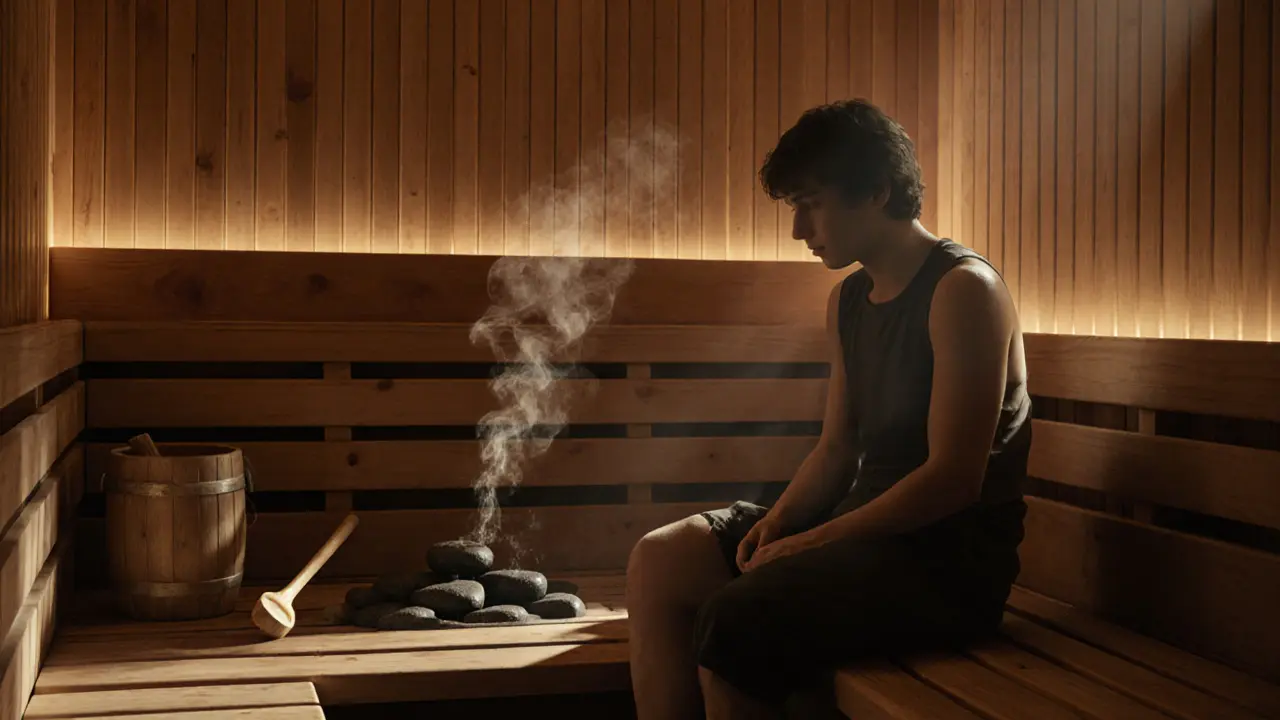
How to Practice or Apply Sauna or Moroccan Bath
Setting Up for Success
At home, you can get a small infrared sauna for under $1,000. For a hammam? Harder. But you can mimic it: take a hot shower, add a few drops of eucalyptus oil, scrub with a loofah, and wrap yourself in a warm towel. It’s not the same-but it helps.
Choosing the Right Tools/Resources
In Dubai, top spas like Al Maha Spa or The Ritz-Carlton Hammam offer authentic experiences. Look for places that use natural black soap and kessa gloves-not plastic scrubs. For saunas, check if they use real wood and stone heaters, not just electric boxes.
Step-by-Step Guide
For beginners: Start with the sauna. Try 10 minutes. Cool off. Repeat once. Then try the hammam. Book a 60-minute session. Don’t rush. Let the steam work. Ask questions. The staff will guide you.
Tips for Beginners or Couples
Many couples love doing a hammam together-it’s intimate without being awkward. Saunas are better solo. If you’re shy, ask for a private room. Both are safe for most people, but listen to your body. If you feel dizzy, leave.
Safety and Ethical Considerations
Choosing Qualified Practitioners/Resources
Look for spas with certified attendants. In Dubai, many hammam therapists are trained in Morocco or have years of experience. Ask if they use natural products. Avoid places that use harsh chemicals or scrub too hard.
Safety Practices
| Practice | Purpose | Example |
|---|---|---|
| Hydrate before and after | Prevent dehydration | Drink 1-2 glasses of water |
| Limit session time | Avoid overheating | Max 20 mins in sauna, 45 mins in hammam |
| Don’t go alone if you’re unwell | Ensure safety | Wait until you’re fully recovered |
Setting Boundaries
If you’re uncomfortable with touch, say so. Most spas will skip the scrub or do it lightly. Your comfort comes first.
Contraindications or Risks
Avoid both if you’re pregnant, have heart disease, or are recovering from surgery. People with low blood pressure should be cautious. Always check with your doctor if you’re unsure.
Enhancing Your Experience with Sauna or Moroccan Bath
Adding Complementary Practices
After a sauna, try 5 minutes of deep breathing. After a hammam, sip herbal tea and sit quietly. Add a few drops of lavender oil to your towel. These small rituals deepen the calm.
Collaborative or Solo Engagement
Saunas are best alone. Hammams can be shared. Some couples enjoy the ritual together-it’s a quiet, intimate way to connect.
Using Tools or Props
For saunas: A wooden bench cushion, a towel to sit on. For hammams: A good kessa glove (find one online), natural black soap, a cotton robe.
Regular Engagement for Benefits
Once a week is ideal. Twice if you’re active or stressed. Consistency matters more than intensity.
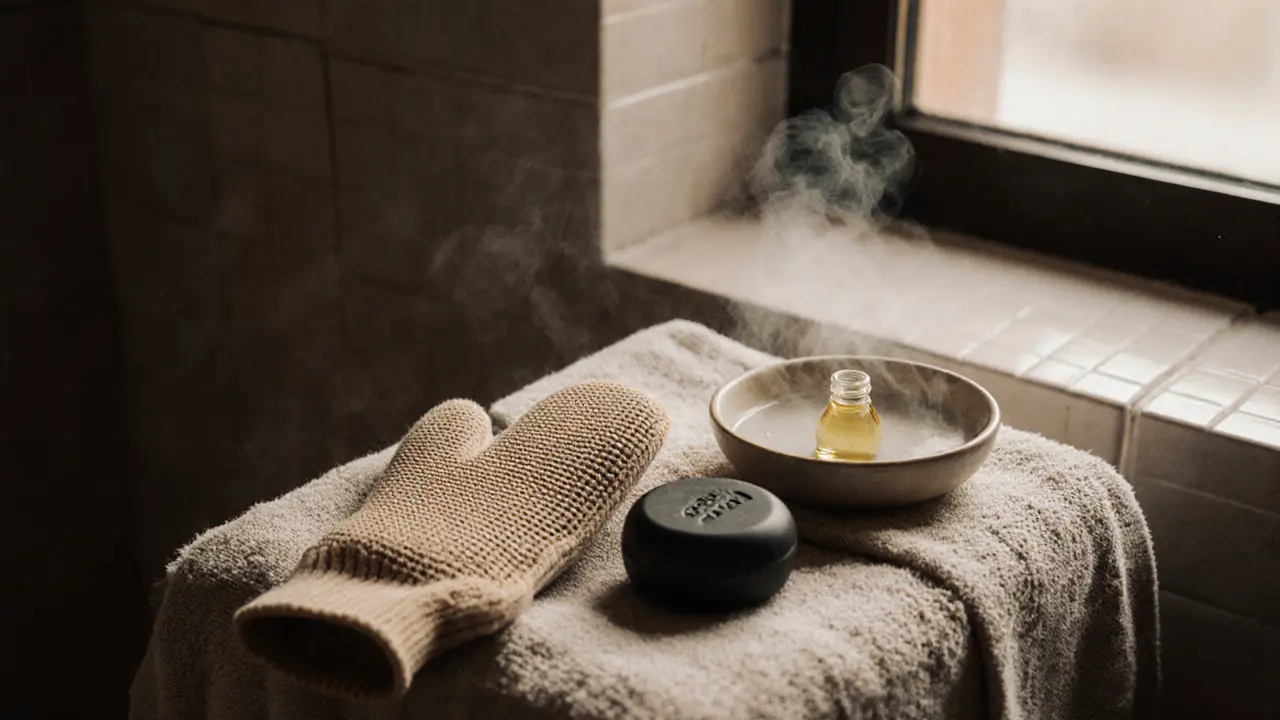
Finding Resources or Experts for Sauna and Moroccan Bath
Researching Qualified Practitioners/Resources
Check Google reviews for spas in Dubai. Look for mentions of “authentic,” “gentle,” or “traditional.” Avoid places with photos of plastic tubs and neon lights.
Online Guides and Communities
Follow wellness blogs like Spa Dubai Insider or YouTube channels that show real hammam sessions. Join Facebook groups for Dubai wellness seekers.
Legal or Cultural Considerations
In Dubai, hammams are gender-segregated. Respect that. Private rooms are available for couples. Always dress modestly in shared areas.
Resources for Continued Learning
Read The Art of the Hammam by Moroccan wellness experts. Watch documentaries on Finnish sauna culture. Knowledge makes the experience richer.
FAQ: Common Questions About Sauna and Moroccan Bath
What to expect from a Moroccan bath?
You’ll start by relaxing in a steamy, tiled room for 10-15 minutes. Then, a trained attendant will scrub your skin with a rough glove and natural black soap. You’ll be rinsed with warm water, wrapped in a towel, and left to rest. You’ll feel soft, clean, and deeply relaxed. It’s not painful-it’s soothing. Many describe it as a “skin reset.”
What happens during a sauna session?
You sit or lie in a dry, hot room (usually 80-100°C) for 10-20 minutes. You sweat heavily. You might pour water on hot stones to create a burst of steam. No scrubbing. No touching. Just quiet heat. You’ll feel your muscles loosen and your mind clear. Afterward, you cool down with a shower or cold plunge. It’s simple, intense, and deeply restorative.
How does a Moroccan bath differ from a sauna?
The main difference is moisture and action. A sauna uses dry heat to make you sweat-passively. A Moroccan bath uses wet steam and physical scrubbing to cleanse your skin-actively. Saunas are about heat stress and recovery. Hammams are about ritual, renewal, and touch. One leaves you refreshed; the other leaves you glowing.
What is the method of a Moroccan bath?
The method is simple: steam, scrub, rinse, rest. You enter a steam room, relax for 10-15 minutes. Then, you’re scrubbed from head to toe with a coarse kessa glove and natural black soap. Your skin is rinsed with warm water, and you’re wrapped in a towel. Often, you’re massaged with argan oil or given a face mask. The whole process takes 60-90 minutes and is designed to deeply cleanse and nourish your skin.
Is a Moroccan bath suitable for beginners?
Absolutely. Most spas in Dubai tailor the experience to first-timers. You can request a lighter scrub, skip the massage, or ask for a private room. The heat is gentle compared to a sauna, and the process is slow and guided. Many beginners say it’s the most relaxing spa treatment they’ve ever tried. Just drink water before and after, and let the staff know if you’re unsure about anything.
Conclusion: Why Sauna and Moroccan Bath Are Worth Exploring
A Path to Deeper Wellness
Neither the sauna nor the Moroccan bath is just a luxury. They’re ancient tools for modern stress. One clears your body. The other renews your skin and soul. Together, they offer a full reset.
Try It Mindfully
Start with one. Try the hammam if you want to feel soft and calm. Try the sauna if you need to release tension fast. Don’t rush. Let the heat speak to you.
Share Your Journey
Tried a Moroccan bath in Dubai? Tell us how it felt in the comments. Follow this blog for more honest, local wellness tips. And if you’re looking for the best spa experience in the city-ask around. The best ones aren’t always the most expensive.
Some links may be affiliate links, but all recommendations are based on research and quality.
Word count: 1,728
Suggested Images
- A serene Moroccan bath interior with tiled walls, steam rising, and a marble slab
- A person relaxing in a traditional Finnish sauna, wooden benches, soft lighting
- Close-up of a kessa glove and black soap beside a towel
- A couple enjoying a private hammam session, wrapped in robes, smiling softly
- Steam rising from a traditional sauna heater with water being poured on stones
Suggested Tables
- Comparison of Sauna vs. Moroccan Bath (already included)
- Key Benefits of Sauna and Hammam (already included)
- Safety Tips for Sauna and Hammam (already included)
